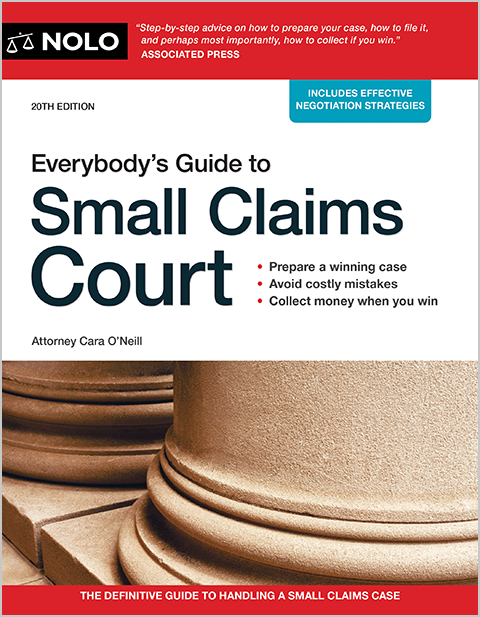When you're sued for causing a car accident, you might have the option of filing a counterclaim seeking your own damages.
After any kind of traffic accident, if someone files a car accident lawsuit against you claiming the crash was your fault, one of your options may be filing a counterclaim in court. Here's what to know at the outset:
- A counterclaim is a specific kind of legal filing through which you might be able to turn the proverbial tables against the person who sued you.
- You can make allegations of your own in a counterclaim—that the person who sued you actually caused the car accident, for example.
- You can also ask the court to award you your own remedy (that means compensation for your injuries, vehicle damage, and other losses).
What is a Counterclaim?
A counterclaim is a legal claim that the defendant in a lawsuit (the person being sued) can file against the plaintiff (the person who filed the original lawsuit). (Get the basics on car accident lawsuits.)
A counterclaim is not a separate lawsuit, and the allegations in it must usually relate to the subject matter of the original complaint—so it must pertain to the underlying car accident, and not to some other legal dispute—although there can be exceptions, which we'll touch on below.
A Counterclaim Isn't an Insurance Claim
It's important to keep in mind that a counterclaim is a legal filing that's part of a larger, court-based lawsuit. It's not a type of insurance claim. If someone involved in your car accident files an car insurance claim for their losses, you can always file your own separate insurance claim (like a third-party claim against the other driver's insurance company) seeking compensation for your own accident-related harm. But that's not referred to as a "counterclaim" in the insurance world (or anywhere else).
How Do Counterclaims Work In Car Accident Cases?
Here's how the standard counterclaim arises in a car accident lawsuit:
- Anna and Barry get into a crash at an intersection
- Anna sues Barry over the accident, claiming Barry was negligent in connection with the crash, and
- Barry thinks Anna was actually at fault for the accident, so he files a counterclaim against Anna.
Assuming that Barry has car insurance, his insurer will likely handle all aspects of the counterclaim, since it's likely that the insurer has already appointed a car accident lawyer to defend the lawsuit in court.
In fact, it's generally the car insurance company, and not the driver, who will decide if a counterclaim should be filed at all. If the driver wants to file a counterclaim, but the driver's insurer doesn't think it's a good idea, no counterclaim will likely be filed.
Let's take a closer look at how the counterclaim in a car accident case will work, in the context of Anna's lawsuit against Barry.
Starting the Car Accident Lawsuit
The lawsuit begins with the service of the "complaint" and "summons" by Anna (the plaintiff) on Barry (the defendant). In many states, Barry will then have a short period of time, possibly four weeks, to determine how he wants to respond. Learn more about starting a personal injury lawsuit.
Responding to the Car Accident Lawsuit
If Barry decides to file a counterclaim, he must file an "answer" to Anna's complaint with the court, and then file the counterclaim according to the court's rules.
Pretrial Processes
Discovery (the pretrial investigation process) will then begin on both the complaint (Anna's original lawsuit) and Barry's counterclaim. During the discovery process, both parties will investigate one another's allegations, using tools like:
- interrogatories (written questions and answers)
- depositions (in-person testimony), and
- requests for production of documents
Keep in mind that the parties are entitled to conduct discovery on the allegations of Barry's counterclaim just as if it was a regular lawsuit.
How Are Counterclaims Handled During a Car Accident Trial?
Let's say that the parties complete discovery and conduct mediation, but the settlement negotiations fail. Now they have to go to trial. Let's look at how a trial proceeds when a counterclaim is involved.
The evidence on the counterclaim is generally heard at the same trial in which the evidence on the main lawsuit is heard. The major difference between presenting evidence on the main lawsuit and evidence on the counterclaim is that it is the defendant (Barry) who has the burden of proving the allegations of the counterclaim (remember that the counterclaim is an independent legal claim, not a defense).
Opening Statements and Presentation of Evidence
In any trial, the plaintiff will make the first opening statement to the jury. Then, the defendant will make an opening statement. After the opening statements, Anna (as the plaintiff) presents her evidence (calling witnesses, entering documents and diagrams into evidence, etc.) first.
After Anna has finished presenting her evidence, Barry will present his evidence on both:
- the original complaint (defending against Anna's allegations) and,
- his counterclaim (proving his own allegations against Anna, including the nature and extent of Barry's damages).
After Barry finishes presenting his evidence, Anna will then have a chance to present additional evidence in response to Barry's case.
Closing Arguments
Finally, the parties will make their closing arguments. The defendant usually goes first and the plaintiff last. But in some states:
- the plaintiff goes first
- the defendant goes second, and
- the plaintiff has the chance to have a short rebuttal.
The Case Goes to the Jury
The judge's instructions to the jury and the jury deliberation form are more complicated when there's a counterclaim.
In a regular car accident case, the jury simply decides if the defendant was negligent, and, if so, they next calculate the plaintiff's damages. When there's a counterclaim, the jury has to:
- decide whether each party was negligent -—and if so, to what extent, and
- determine what each party's damages were.
In order for the jury to understand what it's doing, the judge has to give additional instructions to explain exactly what a counterclaim is and who has what burden of proof.
Getting Help After a Car Accident
If you're thinking about filing a counterclaim as part of a car accident lawsuit that's been filed against you, it's probably time to discuss your situation (and your options) with an experienced legal professional. If your insurance company has appointed a lawyer to defend you, start by talking with them about the prospect of filing a counterclaim.
If no lawsuit has been filed yet, and you're trying to be proactive and protect yourself, you might want to try finding a lawyer on your own. Learn more about how an attorney can help in a car accident case and get tips on getting help from a personal injury lawyer.
Have you been in a car accident?
Take our free car accident quiz to find out if you're likely to get a settlement.



